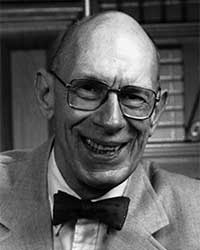
Summary
Frank Henry Field (February 27, 1922 – April 12, 2013) was an American chemist and mass spectrometrist known for his work in the development of chemical ionization.[1][2][3]
Frank Henry Field | |
|---|---|
 | |
| Born | February 27, 1922 |
| Died | April 12, 2013 (aged 91) |
| Alma mater | Duke University |
| Known for | Chemical ionization |
| Scientific career | |
| Institutions | University of Texas Humble Oil Esso Rockefeller University |
Early life and education edit
Frank Field was born in Keansburg, New Jersey, on February 27, 1922. His father died two months after he was born and his mother died in 1933, after which he was raised by his aunt in Cliffside Park, New Jersey. He attended Duke University, where he studied chemistry, receiving his B.S. degree in chemistry in 1943, M.S. in 1944, and Ph.D. in 1948.[4][5]
Professional career edit
Field took a position as an instructor at the University of Texas at Austin in 1947 and became an assistant professor in 1949. In 1952, he took a position as a research chemist at Humble Oil in Baytown, Texas, where he, along with Burnaby Munson, discovered chemical ionization.[6] In 1966, he moved to Esso Research and Development Company in Linden, New Jersey, where he rose through the ranks to become a senior research associate. In 1970 he took a position as a professor at Rockefeller University and became emeritus in 1989.[4][5]
Awards and honors edit
Field was a Guggenheim Fellow in 1963–1964 and was president of the American Society for Mass Spectrometry from 1972 to 1974.[4][5] In 1987 he became a fellow of the American Association for the Advancement of Science.[7] The Frank H. Field and Joe L. Franklin Award for Outstanding Achievement in Mass Spectrometry, given by the American Chemical Society, was created in 1983. Field received the award in 1988.[8]
References edit
- ^ "FRANK H. FIELD Obituary". New York Times. 2013-04-21. Retrieved 2014-10-13.
- ^ Chait, Brian (2014). "Frank H. Field (1922–2013)". Journal of the American Society for Mass Spectrometry. 25 (5): 702–704. Bibcode:2014JASMS..25..702C. doi:10.1007/s13361-014-0866-3. ISSN 1044-0305. PMID 24658810. S2CID 11398163.
- ^ "Frank H. Field, Pioneer in Mass Spectrometry and the Study of Gaseous Ion Chemistry, Dies at 91". Retrieved 2014-10-13.
- ^ a b c Center for Oral History. "Frank H. Field". Science History Institute.
- ^ a b c Grayson, Michael A. (10 December 2009). Frank H. Field, Transcript of an Interview Conducted by Michael A. Grayson at Durham, North Carolina on 9-10 December 2009 (PDF). Philadelphia, PA: Chemical Heritage Foundation.
- ^ Field, F. H. (1990). "The early days of chemical ionization: A reminiscence". Journal of the American Society for Mass Spectrometry. 1 (4): 277–283. doi:10.1016/1044-0305(90)85001-3. ISSN 1044-0305. PMID 24248819.
- ^ "Frank Field". American Association for the Advancement of Science. Retrieved 20 February 2018.
- ^ "Frank H. Field and Joe L. Franklin Award for Outstanding Achievement in Mass Spectrometry". American Chemical Society. Retrieved 20 February 2018.
External links edit
- Center for Oral History. "Frank H. Field". Science History Institute.
- Grayson, Michael A. (10 December 2009). Frank H. Field, Transcript of an Interview Conducted by Michael A. Grayson at Durham, North Carolina on 9-10 December 2009 (PDF). Philadelphia, PA: Chemical Heritage Foundation.
Further reading edit
- Frank Henry Field; Joseph Louis Franklin (1970). Electron Impact Phenomena and the Properties of Gaseous Ions. Academic Press. ISBN 978-0-12-255450-6.


